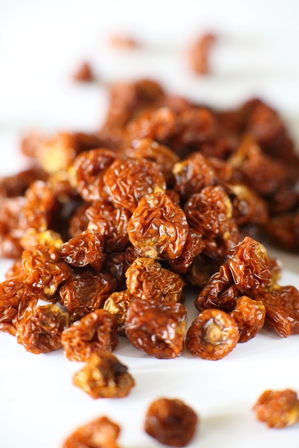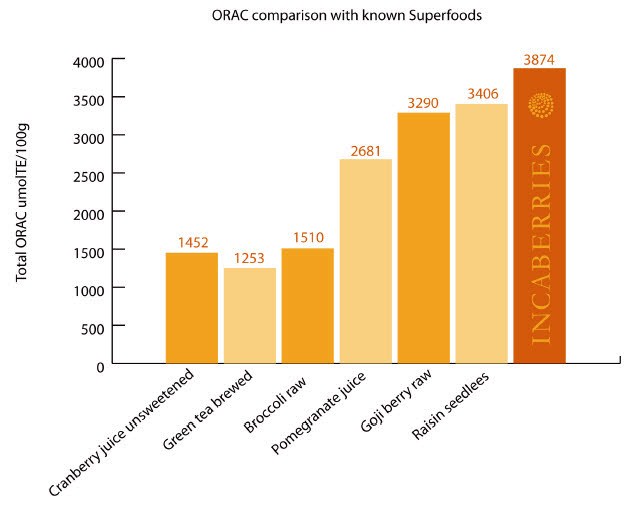Product review: Incaberries: a new “super berry”?
Written by Catherine Saxelby
on Sunday, 02 October 2011.
Tagged: antioxidants, fresh food, healthy eating, review, super foods

You’d think we’d discovered all the super berries. After all, we’ve had years of hype for cranberries, goji, noni, acai and mangosteen. Now there’s a new berry in your health food aisle. It’s the Incaberry!
Background
Incaberries (Physalis peruviana) are indigenous to South America but were only introduced into Australia in 2011. When fresh, the fruit is round, bright orange and about the size of a large marble. Once dried however - which is how you’re likely to spot them - they have a golden-bronzed colour with small edible seeds about the size of sesame seeds. Sounds hard work but you crunch into them the same way as you eat the tiny seeds of figs or raisins.
Taste 7.5 out of 10
Incaberries have a complex taste. Initially you get a burst of sweetness followed by a slightly sour aftertaste, not unlike the tang of a dried apricot. Both the chewy pulp and crunchy seeds give them a texture similar to dried figs.
The tangy flavour is strong and may not appeal to everyone. Personally I like it but then I’m a fan of dried apricots for just this reason. If you are too then you’ll probably love snacking on Incaberries on their own. However, if you don’t, the best way to eat them is to combine them with other ingredients as a flavour enhancer.
Ways to eat Incaberries
 You can use Incaberries in exactly the same way as you’d eat any other dried fruit:
You can use Incaberries in exactly the same way as you’d eat any other dried fruit:
-
- as a snack on their own or mixed with nuts (I love them teamed with pecans or walnuts)
- sprinkled over your usual breakfast cereal or mixed into muesli
- a couple of spoonfuls tossed in with couscous or quinoa salads
- served with cheese - they are decorative, so work well as a garnish and the flavour contrast is similar to the trendy quince paste
- added to yoghurt or fruit salad
- used to bake muffins, scones, biscuits or slices
- used as part of the dried fruit mix you normally use to make a fruit cake.
- Their flavour also works well in chicken or turkey dishes, Moroccan casseroles and Indian curries
Nutrition 8 out of 10
How do Incaberries compare with other similar dried fruits? Incaberries have more kilojoules than dried apricots or sultanas thanks to a combination of carbs in the fruit and healthy fats in the tiny seeds
Like other dried fruit, about half their weight is carbohydrates with a lot of natural sugars. They’re around 50 per cent sugars - on a par with dried apricots.
For a fruit, they are surprisingly high in protein (6.4 g per 100 g), however, they’re not as high as goji which has 12 g. As a comparison meat is 20 per cent protein which means meat is 20 g per 100 grams.
At 19 per cent, they have the highest fibre content of all dried fruit. A handful delivers about 8 g which is 27 per cent of the recommended daily intake for an adult. Most of the other dried fruits contain about 8 g, although dried figs come a close second with 14.3 g fibre. It’s all due to those tiny seeds.
Their potassium level equals that of apricots but they come up tops for their phosphorous content. There’s not much calcium (dried figs outshine them here and actually contain about 10 times more calcium than Incaberries).
Nutritionally I like to think of them as a cross between dried figs and dried apricots.
What’s in Incaberries
Per 100g
1220 kJ (290 calories), 6 g protein, 3 g fat, 0.5 g saturated fat, 19 g fibre (including 4 g soluble fibre), 24 mg calcium, 1500 mg potassium.
Per serve (1/4 cup is 45 g or a handful, about 35 Incaberries)
550 kJ (130 calories), 3 g protein, 1 g fat, 0.2 g saturated fat, 9 g fibre (including 2 g soluble fibre), 11 mg calcium, 675 mg potassium.
Note: the Incaberry site uses ¼ cup for 45 g serve.
Do the claims stack up?
The marketing for Incaberries makes much of the fact that they are rich in fibre and antioxidants.
1. Fibre
It’s true that Incaberries are high in fibre – with double the fibre of most dried fruits including prunes, apricots and sultanas.
A handful (45 g) supplies more than a quarter of an adult’s recommended daily fibre intake. What a mighty fibre-boost to sprinkle on your morning muesli!
Interestingly Incaberries contain both insoluble and soluble fibre. Insoluble fibre is important for healthy bowels function, while soluble fibre helps increase satiety and reduces cholesterol re-absorption.
2. Antioxidants
 Incaberries are a good source of antioxidants with their ORAC rating (measure of antioxidant capacity) surpassing many well known “superfoods”.
Incaberries are a good source of antioxidants with their ORAC rating (measure of antioxidant capacity) surpassing many well known “superfoods”.
In particular, Incaberries are rich in polyphenols, the same group of helpful compounds in tea and pomegranates. Research has found the antioxidants in Incaberries may also have anti-inflammatory qualities.
Bear in mind that the graph (supplied by the Australian Incaberry importer) compares 100g portions of seven foods. This does not reflect the usual size of the portions we eat. While it’s easy to sip 200ml of green tea, for example, it’s not easy to eat 200g of Incaberries. A serve is about a quarter of that - 45 grams.
Keeping in mind the limitations of all methods for measuring antioxidants, I’ve come to the conclusion that Incas are at the top of the antioxidant ranking and worth eating for this reason alone. A few Incas a day add a zip and zing to your dishes and may top up those anti-ageing antioxidants.
The tiny seeds (once again) are the key to the fruit’s strong antioxidant capacity.
3. Vitamins and minerals
Yes they contain vitamin C but quite low levels. They make up for this with a strong antioxidant capacity and lots of phosphorus and potassium.
4. Other claims
Incaberry marketing claims they are gluten free, have no cholesterol and are very low in sodium. But this could be said about ALL fruit.
5. Organic, no preservatives
Finally they are organic and preservative-free. Many dried fruits like apricots and apples contain preservatives (e.g. sulphites) to preserve the colour, but this is not the case with Incaberries. But be aware, their colour may darken slightly over time, but this doesn’t impact their taste or nutritional value.
Cost
The process of five months of pruning, organically growing and manually harvesting makes Incaberries labour intensive and therefore expensive. At a local health food shop, a 100 g packet of Incaberries cost $4.20 ($1.89 per 45 g handful), which makes them around one and a half times as expensive as dried apricots and more than three times as expensive as dried figs! But not as expensive as goji and acai so a more affordable super berry! See cost comparison below:
Dried apricots (Coles Angus Park $5.89 per 200 g which is $2.95 per 100 g)
or
Dried figs (Deli Sykiki Brand $4.95 per 375 g which is $1.32 per 100 g).
You’ll find Incaberries in health food stores, greengrocers and specialty stores.
Convenience 10 out of 10
Open the packet and enjoy straight away or use in your cooking as an ingredient.
Research and tasting notes contributed by dietitian Jo Mollica.
- Reference: Franco LA, Matiz GE, Calle J, Pinzón R, Ospina LF. Antiinflammatory activity of extracts and fractions obtained from Physalis peruviana L. calyces. Biomedica. 2007;27(1):110-5. https://pubmed.ncbi.nlm.nih.gov/17546228/
You may also be interested in...
References / External articles
Foodwatch
The Good Stuff
The Boring Stuff
© 2025 Foodwatch Australia. All rights reserved
Website by Joomstore eCommerce





